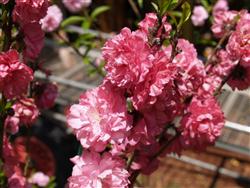Prunus
 Prunus
Prunus
Family: Rosaceae
- Approximately 200- 400 species of deciduous or evergreen trees and shrubs, mainly from temperate climates.
- Leaves are simple and alternate. Ornamental varieties are grown for attractive flowers (often called blossom) or fruit.
- Flowering is normally profuse (ie. large numbers of flowers cover the entire plant) in late winter or early spring. Cropping varieties are grown for their edible fruits.
Prunus are temperate climate plants, hardy on most soils (except poorly drained ones), and best suited to places with a cold winter.
Some require a hot summer, others a mild summer.
They all do best in full sun or very light shade. Most tolerate dry periods but should be watered during extended drought.
Some “tropical” varieties of plums, apricots, peaches and nectarines, have been bred in recent years.
These plants will perform reasonably well without needing the cold winter usually required by prunus.
Most varieties can be grown with minimal attention; however, to get the best from any prunus, they should be fertilised, watered and mulched periodically; pruned annually (normally in winter), and treated against pest and disease problems which can flourish on them. A wide range of pests (aphis, caterpillars, borers, birds, etc) can attack foliage, flowers, wood or fruits. Fruit, flowers and to a lesser degree foliage and wood can be susceptible to a variety of fungal diseases. Without protection or regular spraying, the fruit crop can be decimated; or the ornamental affect of decorative fruits can be lost.
Cultivars
With up to 400 species, it is difficult to cover their potential on one page; however, most of them are small trees, with relatively few serious problems. Many are ideal for a small garden. If space is severely limited, they are ideal as an espalier on a wall or fence line.
The more commonly cultivated species are
P. americana (American Plum) to 7m tall
P. amygdalus (Almond) (syn: P. dulcis) to 8m tall
P. armeniaca (Apricot) to 6m tall
P. avium (Sweet Cherry) to 8m or taller
P. cerasifera (Cherry Plum) to 7m tall
P. cerasus (Sour Cherry) 3 to 6m tall
P. domestica (European Plum) 5 to 7m tall
P. insititia (European or Damson Plum) 5 to 6m tall
P. hortulana (American Plum) to 8m tall
P. mume (Flowering Apricot) to 8m tall
P. persicae (Peach) to 6m tall
P. serrulata (Flowering Cherry) to 16m tall
P. subhirtella var. pendula (Weeping Flowering Cherry) to 7m tall
P. salicina (Japanese Plum) to 7m tall
Flowering cultivars
There are many cultivars that are grown primarily for their flower. These vary in size from low plants only 1 to 2 m tall, to much taller trees.
Prunus ‘Elvins’ is a popular cultivar that arose as a seedling in Melbourne in the first half of the 20th century. It flowers very heavily, and is perhaps only up to around 3m tall.
Prunus blireana, is a much taller cultivar, grown both for its dark a purple foliage, and its pale pink blossom.
Learn More about Plants through an ACS Plant Variety course.
Click for details: http://www.hortcourses.com/courses/product_listings.aspx?catid=Plant+Varieties
For Australian Native Plants, Click here http://www.hortcourses.com/courses/product_listings.aspx?catid=Australian+Native+Plants
You may also be interested in....
Exceptional training for a serious business or career -lots of different options to specialize.
View Course